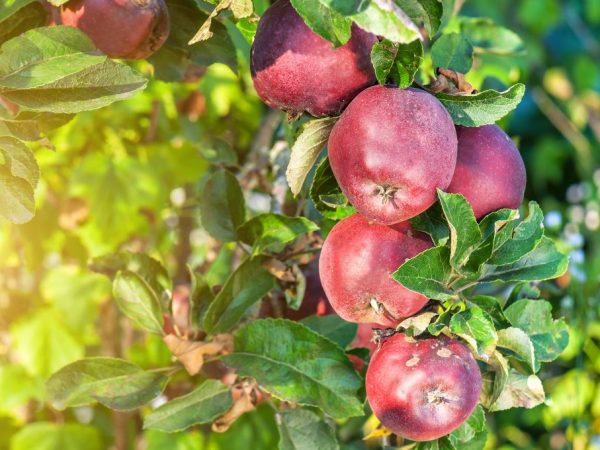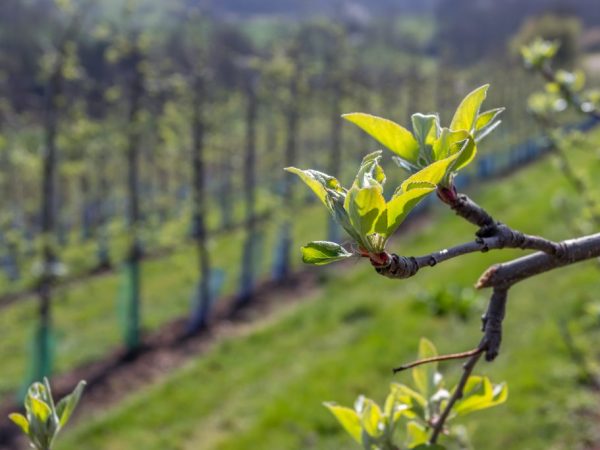Apple variety Red Delicious
Apple tree Red Delicious is one of the most popular varieties, on the basis of which many subspecies have been derived. It appeared in America as a result of an accidental mutation noticed by a private gardener. He grew delicious apples and after 10 years sold the rights to them to a large nursery, which spread the variety all over the world.

Apple variety Red Delicious
Characteristics of the variety
The apple tree of this variety is medium-sized, grown on different rootstocks. On a dwarf - it reaches 4 m, on a seed - 5-6 m. At a young age, the crown of a tree has an oval shape, over time it becomes spherical. Leaves are oval, intense green color with shine. Flowering is abundant.
Fruits are medium and large in size (from 150 to 350 g). The peel of apples is dense, dark red on a green-yellow base; the blush is dark crimson. The pulp is creamy with a greenish tint, very juicy and crunchy.
The flavor ranges from sweet and sour to sweet and sour depending on growing conditions. The calorie content of apples is 45-50 kcal per 100 g.
Pollination
The Red Delicious variety can be self-fertile, but the percentage of pollen viability in apple trees is not very high. For good yields, the proximity of pollinating varieties is necessary.
This role is successfully handled by Golden Delicious, Gloucester, Jonathan, Idared, Empire and others.
Yield
Fruiting begins at 4-5 years of age, but much depends on the rootstock (later on seed).
The first few years, harvests from one tree are no more than 20-35 kg, but by 10 years they can be increased to 80-120 kg.
Under favorable conditions and good care, more than 160 kg are received.
Resistant to frost and drought
The apple tree has an average frost resistance - it tolerates temporary frosts, but not long harsh winters. In any case, the tree needs to be insulated for the winter.
Drought has a bad effect on growth and productivity, therefore, during dry periods, it is regularly and abundantly watered.
Diseases and pests
The apple tree is highly resistant to bacterial burns, as well as to powdery mildew. Sensitivity to rot and vitreousness is noted. The resistance to scab is average.
Cooking applications

Apples are best eaten fresh
Red Delicious apples are more suitable for fresh consumption, since the juicy pulp does not tolerate heat treatment well.
This is the perfect snack between meals. They can also be used to prepare fruit and vegetable salads.
Advantages and disadvantages
The apple tree has established itself for a long time - more than 100 years ago. She has more advantages than disadvantages. When purchasing this variety, it should be remembered that with good tree care it is possible to compensate for many weaknesses.
Dignity
- Delicious, beautiful and large fruits;
- High productivity;
- The dense peel protects the fruits from damage - good keeping quality and transportability;
- Resistant to powdery mildew and fire blight;
- Unpretentiousness to the composition of the soil;
- The crown is formed naturally - the tree needs only sanitary pruning;
- Resistant to frost in temperate climates.
disadvantages
- Unsuitable for cold regions with harsh winters;
- Susceptibility to vitreousness and rot;
- The fruits are not suitable for heat treatment;
- The tree can hardly tolerate drastic weather changes.
Landing
In cold regions, planting is definitely carried out in the spring, in warmer regions it is possible in the fall.
In the autumn, the apple tree is planted a month before the first frost; for this, two-year-old seedlings are selected on a seed, dwarf or semi-dwarf rootstock. The planting scheme (or the distance of a single tree to the nearest neighbors) depends on the choice of the stock.

Planting is done in spring
The seed stock assumes a distance of 5 m, semi-dwarf - 4 m, dwarf - 3 m.
The place should be sunny, away from groundwater. Do not plant in lowlands where melt water can accumulate.
It is better to prepare for planting in a month - to dig up the soil and apply fertilizers (compost, manure, ash, nitroammofoska).
Landing technology
Usually, holes are dug for seedlings with a depth of 80 cm and a diameter of 70 cm. Drainage is laid at the bottom, and a layer of soil mixture with peat or compost is placed on top.
The seedling is placed in a hole, covered with earth and watered with three buckets of water. After watering, the trunk circle is mulched with a peat layer.
To protect from the wind, a peg is placed next to it and a seedling is tied to it.
Agrotechnics
According to the description of the rules of agricultural technology, the first few years after planting the Red Delicious variety, you need to carefully process the near-trunk circle of the apple tree - weed weeds and loosen the ground.
The tree is watered 2 times a month, in dry periods - once a week. In the spring it is fed with nitroammophos, and during flowering, ash is added to the soil. During the period of fruit ripening, fertilizing with potash fertilizers is necessary.
Crown formation is not a problem - as the tree grows, it becomes spherical. To help the process, you can thin out densely growing shoots that are directed towards the inside of the crown. In addition, annual sanitary pruning of dry and damaged branches is required.
Another care measure is the prevention of pests and diseases - it is carried out before flowering. For the winter, the tree is insulated - mulch and cover the trunk with burlap.
Harvesting and storage
If the summer is warm, the fruits ripen by the beginning of September, and if the summer was cool - by the beginning of October. The apples are well attached to the branches and do not fall off, so the harvest is carried out without problems. Due to the dense skin, the fruits are resistant to mechanical damage and have excellent keeping quality.
You need to store the crop in a refrigerator or basement at a temperature of 0-1 ° C.
Apples can lie up to 7-8 months, but by the end of the period their taste decreases - the flesh becomes friable.
In addition, fruits may be prone to bitter spotting during storage, especially if they were harvested wet.
Gardeners reviews
According to gardeners, the Red Delicious apple variety fully matches the description. The fruits grow large with a dense skin, the taste is sweet with a more or less pronounced sourness. Productivity is consistently high. They persist until April, but by this time they taste somewhat "cottony".
With good care, the tree is not very demanding on soil fertility. Young ones sometimes freeze in winter, so they need to be carefully insulated (in the first winter after disembarkation they are completely wrapped up).

